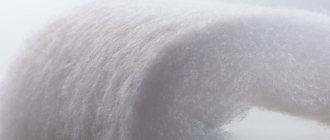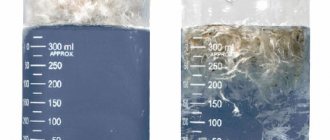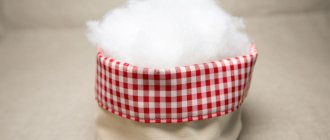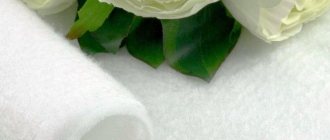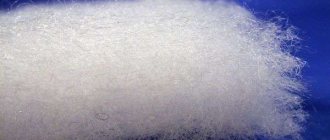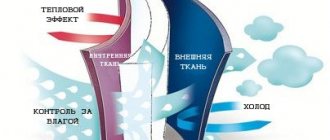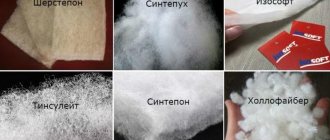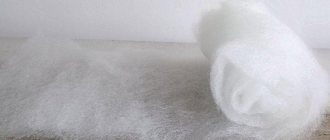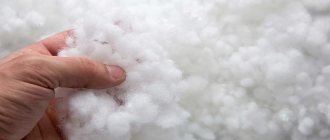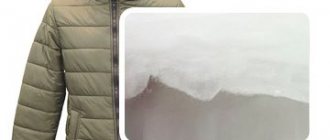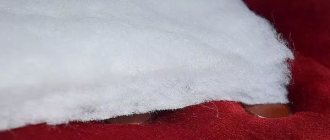The purpose of warm clothes is not to keep you warm.
It should protect from the wind, maintain air ventilation and retain the heat generated by our body. And the more a person is in motion, the more heat he emits. When choosing the amount of insulation in clothing for yourself or a child, you need to focus on this feature. The faster the baby, the lighter his clothes. Sintepon consists of polyester fiber. There are 3 ways to fasten it: adhesive, thermal, needle-punched. Adhesive-based padding polyester is prone to caking, gets loose when washed, is not environmentally friendly due to the presence of glue, and has poor thermal insulation despite its large weight.
Sintepon bonded by heating is better, it is environmentally friendly and does not cause allergic reactions. In needlepunched fibers, the fibers are held together by fiber needles; they have different directions. Items with filling made using the latter method are elastic and retain their shape well.
This filler can have a density from 50 to 600 g. per m². A person feels comfortable in clothes with a padding polyester lining in the autumn-spring period and warm winter. For frosty winters, it is worth choosing jackets with more modern filling.
On a note! Glued padding polyester cannot be washed. Dry cleaning is recommended. The needle-punched and thermally bonded material tolerates washing well in the washing machine.
Variety of insulation materials
The modern market of outerwear for children and adults offers the following insulation materials:
- holophane;
- padding polyester;
- holofiber;
- down and feather;
- fleece;
- artificial fur;
- natural fur;
- isosoft;
- Thinsulate.
Not all of them are common, but the most popular among them are padding polyester, holofiber, and sheepskin.
Popular combination options
Sometimes you can find combined options. For children, an option such as padding polyester and a sheepskin vest is used. What properties does the synthetic winterizer 200 filler have, and what temperature is outerwear with it suitable for? If the winter promises to be warm, this will be the best option. This is due to several simple reasons. These include, first of all, price and quality, or more precisely, the ratio of these parameters.
What factors are important when purchasing?
Sintepon 200 g/m2 - at what temperature can you wear it and not freeze? What do we pay attention to when buying outerwear?
- Appearance. To look good, it is important to choose the option that will hide the flaws of the figure and at the same time emphasize its advantages.
- Comfort while wearing is necessary in order to feel confident and comfortable.
- The price depends on the manufacturer, and it is important that it does not hit your pocket too much.
- Warmth, as a rule, comes first, especially if a person understands what clothes he will freeze in.
To avoid getting into trouble and choose an option that can safely be called optimal, you must first study the properties of a particular material used as insulation. What about the filler synthetic winterizer 200? We will find out what temperature it is designed for, having received the most important information about all the insulation materials used, then you can choose the one that will meet all your requirements.
Nuances and properties of materials
The prices for this or that insulation are not always justified. If we talk about isosoft, then it is necessary to say that it is produced in Belgium. Consequently, the buyer will have to pay not only the cost of material and tailoring of the product. The final price also includes payment of customs duties and transportation to the destination. If you pay attention to the properties of this insulation, it becomes clear that to achieve a similar effect you can use a triple layer of padding polyester. It will be much cheaper. It is for this reason that isosoft is very difficult to find in post-Soviet countries.
You can often find synthetic winterizer 200 insulation. What temperature is it designed for? At the same time, it is also important to understand that padding polyester is a material that can be connected in different ways. The fibers of this insulation can be connected by adhesive or thermal methods. Both methods are used equally. But if we talk about the thermal method, then under the influence of high temperature the insulation layer becomes a little thinner, the consequence of this is less heat retention when compared with the adhesive bonding method.
So, you have decided to buy a winter jacket using synthetic winterizer 200 insulation. What temperature is it designed for? This material can easily withstand winter frosts down to -10 degrees Celsius. This corresponds to a warm winter.
Features of padding polyester with a density of 100, 200, 300 g/sq.m
Sintepon in rolls is a universal filler that is actively used in a wide variety of industries. The density of the material determines its purpose. For example, an indicator of 100 g/sq.m is perfect for making spring clothes, furniture and toys, and 200 and 300 g/sq.m should be chosen for sewing winter items (jackets, coats). The higher the indicator, the warmer the product will be.
When choosing filler 100, 200, 300 g/sq.m in rolls, you should pay attention to three main criteria that indicate the high quality of padding polyester:
- color - high-quality material without impurities has a snow-white color and opaque structure, and it does not shine in the light;
- the canvas should feel soft and elastic to the touch at the same time; a good filler will hold its given shape for a long time;
- An important indicator of the quality of padding polyester is elasticity - the material stretches well and does not tear, and thick fabric can be divided into several layers without much effort.
If the filling you like for toys, furniture, or clothing meets the above criteria, you have a first-class padding polyester that will last a long time and will successfully perform its insulating and insulating functions. Unfortunately, the market offers a lot of low-quality and defective products in rolls, so you should approach the choice of padding material as thoughtfully and carefully as possible.
Baby clothes
If we talk about children's outerwear, then parents are always very concerned about the question: padding polyester 200 - at what temperature can the child be dressed? It is worth initially noting that any filler does not warm the body, its effect is to retain the heat generated by the body, in which case a child or adult will not freeze even in severe frost. But for this you need to choose insulation that matches the temperature conditions. For children, padding polyester 200 can be worn at what temperature? Down to -7 degrees, you can freely and without doubt wear a jacket with such insulation.
Features of padding polyester products of different densities
A good item with padding polyester filler, regardless of its density, should have a number of characteristics:
- heat-saving effect;
- volume, elasticity and lightness of products;
- recovers quite easily after washing;
- hypoallergenic;
- tolerates both dry cleaning and washing at home at a temperature of 30 degrees;
- there are no conditions for the appearance of saprophytes, mold and moths.
The low cost of the material allows it to be used in a wide variety of areas of life. Filling of different densities is used not only in outerwear, but also in the textile industry for sewing quilted bedspreads, blankets, as a layer in mattresses, pillows and soft toys.
Sintepon is actively used in the production of upholstered furniture; it is placed between the upholstery and the foam base to soften the seats. Even in the aquarium industry there is a place for padding polyester; it is used in water filters.
Important! The higher the density, the thicker the filler layer. Clothing for cold weather will make you feel clumsy.
What is the difference between density 60 and 400 g/m²
The difference between the smallest and largest density of padding polyester is its weight, volume and heat-saving ability. Density 60 can be used in very thin raincoats, light bedspreads, etc. But a seal with a density of 400 g/m² is suitable for jackets that can be worn in 30-degree frost.
Melting point of padding polyester
The polyester fibers from which the padding polyester filler is made melt at a temperature of 250 degrees. When heated to 180, it loses its strength. Therefore, when ironing, you need to set the temperature correctly so that the product lasts longer. Washing is recommended with a water temperature of 30–40 °C on a delicate cycle.
What density of padding polyester in jackets and overalls is suitable for a child depending on the season
All children are different, some run in circles the entire walk, while others prefer to contemplate the world around them while sitting in a stroller. Depending on your mobility, you should choose clothes. Sintepon as a filler for children's outerwear has proven itself to be not the best option. It is good for temperatures down to -10 -15 degrees. Moreover, the layers of insulation in different parts of the clothing are uneven. The most insulated areas are the torso, knees, butt, and elbows. But the sleeves and pants of the overalls are made thinner so as not to restrict movement. Moving body parts generate more heat.
Buying one jacket for the entire cold period is not an option. At temperatures outside the window down to -10 degrees, overalls with insulation of 100–200 g/m² are suitable; for -15 °C it is better to choose a density of 300. Jackets with quilted vests will help you save your family budget. Inactive babies should not be wrapped in very warm clothes; thick filling will make them even more clumsy. It is better to take shorter and more frequent walks, allowing the child to warm up at home.
Important! Sintepon is a budget insulation material for outerwear. Despite the emergence of more modern fillers, it continues to be used and, with proper care, can serve for quite a long time.
Merino animal
What is better padding polyester or holofiber?
Sintepon
In order to understand what temperature padding polyester 200 can be worn at, consider the table corresponding to the volume of insulation and the temperature of the season at which it can be worn freely and not freeze. Sintepon can have different volumes, depending on which outerwear is selected for the winter period or for the cold autumn-spring.
| Type of insulation | Air temperature | Season |
| 100 g/m2 | +5 degrees Celsius | Warm autumn |
| 150 g/m2 | -5 degrees Celsius | frosty autumn |
| 200 g/m2 | -10 degrees Celsius | warm winter |
| 250 g/m2 | -20 degrees Celsius | Cold winter |
| 300 g/m2 | -25 degrees Celsius | very cold winter |
In accordance with the data contained in this table, you can easily choose the best option for outerwear for both adults and children. If you look at these parameters and compare actual air temperature indicators, you don’t even have to worry about the fact that you or your child will freeze in the chosen jacket or coat.
The volume of insulation is a determining factor when purchasing outerwear for children and adults. But at the same time, you need to remember and understand the following: insulation does not heat, it simply retains the heat that your own body produces. In children, this ability is not as pronounced as in adults, so for them it is necessary to use more voluminous insulation options.
Membrane with 200 insulation at what temperature
For young mothers who have not yet delved into all these subtleties about companies, about the amount of insulation and about HOW to dress a child in winter, I decided to write a short review article. Information from the Internet and based on my little experience! Comments and edits are welcome!
Manufacturers usually indicate the amount of insulation on labels/descriptions using numbers or icons (snowflakes). Attention! All children have different frost resistance, so the temperature limits are approximate!
About the insulation:
1. Insulation 80-100 g (or one snowflake) - demi-season option, designed for temperatures from +15 to +5.
At different times I had waterproof overalls Hippychick, Reima, Lassie for this temperature regime
2. Insulation 160-180 g (or two snowflakes) - an option for late autumn/warm winter. Designed for temperatures from 0 to -10
If trousers or overalls, then 100-140 degrees is enough for this temperature range.
I had a Reima set for this temperature range: jacket 160 g and pants 140 g.
3. Insulation 200-250 grams (or three snowflakes) - an option for winter frosts. Designed for temperatures from – 10 to – 25
If trousers or overalls, then 150 degrees is enough for this temperature range.
For this temperature regime I had a Pilguni 240 g overalls, Ticket to Heaven 240 g
4. Insulation 300-330 g - usually chosen for sedentary children (newborns) as a winter option.
For this temperature regime I had a set of Kerry 300 g, Bibon 300 g
About thermal underwear:
When should you wear thermal underwear? – When the overalls/jacket contains a membrane or fabric that has vapor permeability properties.
For a child from birth to 1-1.5 years old, we choose thermal underwear containing at least 50% natural fabrics. Either linen is made from 100% wool or silk-wool, wool+cotton.
Some companies have two-layer options for babies: the top layer is wool, and the inner layer, adjacent to the skin, is cotton (for example, Joha).
Most likely, at temperatures down to -10 degrees, nothing more than thermal underwear and outer overalls will be needed.
Perhaps nothing will be needed even in cold weather - reviews show that when buying merino thermal underwear, mothers save on additional insulation. Plus you need to take into account how many grams of insulation are in your overalls.
Active children (from 1.5-2 years and up to college) will benefit from thermal underwear made of polypropylene, polyester and other synthetics mixed with cotton or wool - or pure synthetics.
At temperatures below -10 degrees, you may need additional fleece or wool underwear - again, it all depends on the quality of the outer overalls.
If you are buying 100% wool underwear for an older child, be sure to try it on to check the sensations. Many children immediately feel discomfort, despite all the tenderness of products made from merino or llama.
